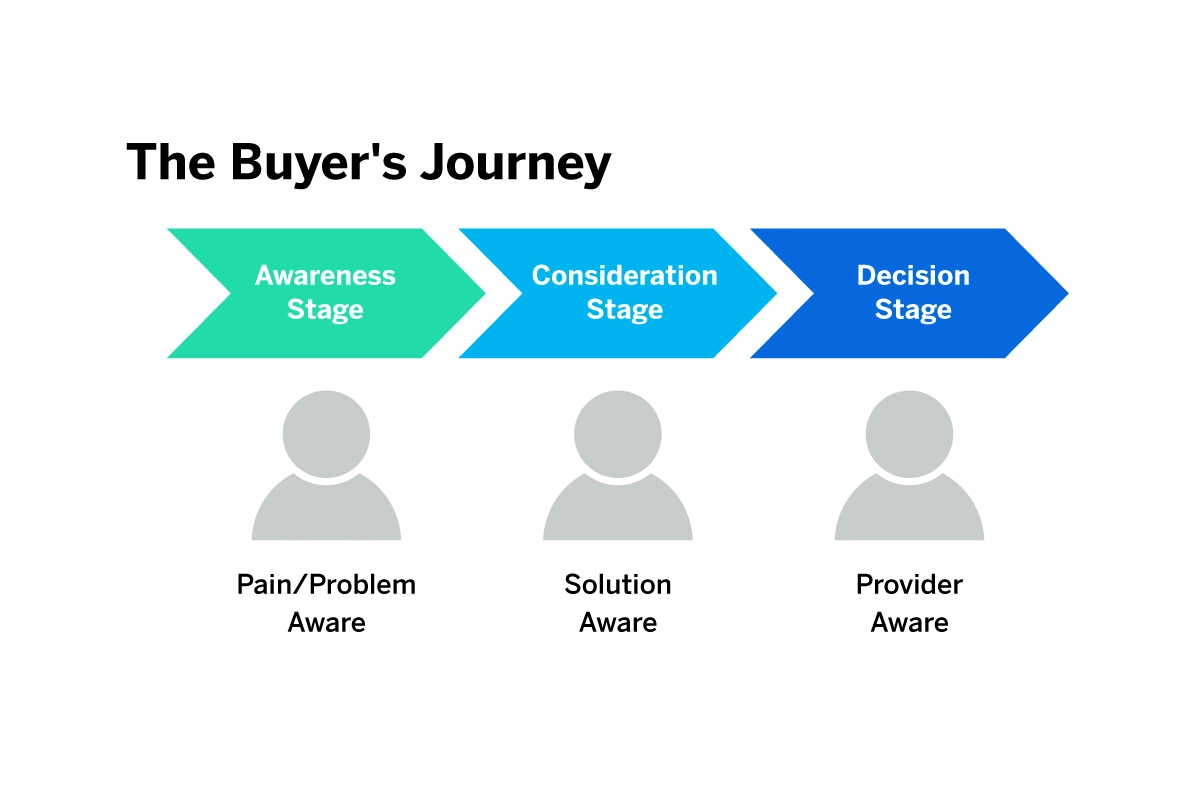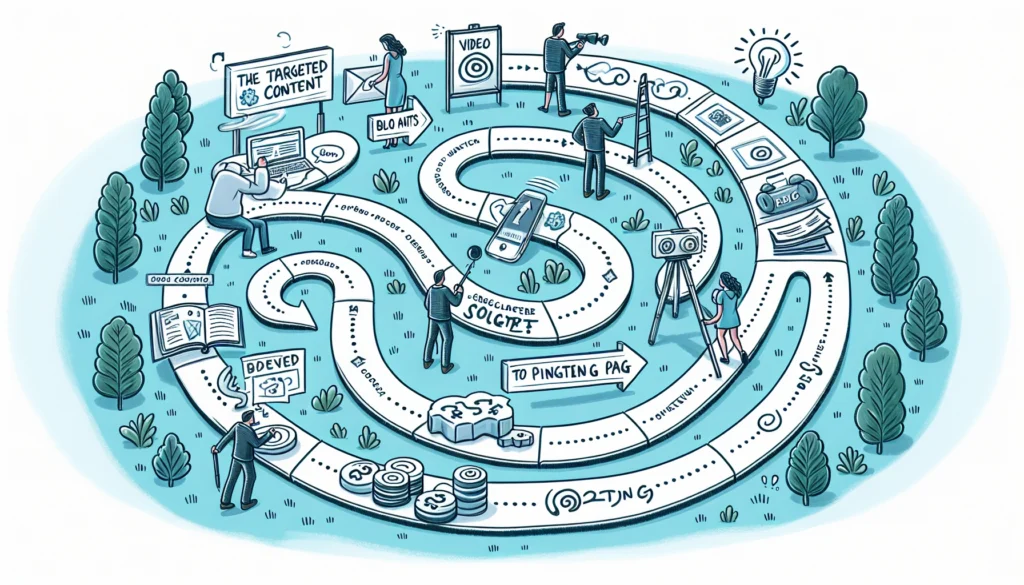Table of Contents[Hide][Show]
The “What is the buyer’s journey?” is a question many businesses seek to answer, as it is the process through which prospective customers become aware of, consider, and decide to purchase a new product or service. This journey is crucial for businesses to understand as it shapes their marketing and sales strategies. In this article, we’ll explore the buyer’s journey stages in detail, including the awareness, consideration, and decision stages and how they impact sales, enabling you to effectively guide customers from initial awareness to final purchase.
Defining the Buyer’s Journey

So, what exactly is the buyer’s journey? It’s a process that customers go through before making a purchase, from recognizing a problem, evaluating potential solutions, to finally acquiring a suitable solution. At each stage of the buyers journey, from awareness through consideration to the decision stage, customers require different information and interactions. This journey helps businesses map out customer interactions, actions, and decisions at each step, allowing them to understand their behavior. It’s like stepping into the shoes of your customer and experiencing the purchasing process from their perspective.
Fascinatingly, a significant portion of the B2B buyer’s journey happens online before a lead even engages with a salesperson. And it’s not always a straight path; customers may revisit stages, making the journey quite non-linear. By examining the buyer’s journey, businesses can provide informative content to help customers navigate their way to a purchase, understanding their challenges, and addressing them effectively.
The Buyer’s Journey vs. Customer Journey
Now, you might be wondering, isn’t the buyer’s journey the same as the customer journey? Not quite. While both are crucial aspects of a customer’s interaction with a business, they cater to different elements and require distinct approaches.
The buyer’s journey is a general concept of a customer’s path to purchase. It focuses on the steps a customer takes from:
Acknowledging a problem or need
Researching potential solutions
Comparing options
Finally making a purchase decision.
On the other hand, the customer journey is a broader view of the customer’s entire experience with a brand. It includes the buyer’s journey but also encompasses post-purchase experiences and interactions with the brand. In essence, while the buyer’s journey ends with a purchase, the customer journey continues, focusing on fostering customer loyalty and encouraging repeat purchases.
Three Key Stages of the Buyer’s Journey

Understanding the stage of the buyer’s journey is crucial for businesses. The buyer’s journey can be broken down into three key stages: Awareness, Consideration, and Decision. Each of these buyer’s journey stages presents unique challenges and opportunities for businesses to engage with their customers.
During the Awareness stage, customers identify a challenge or need without necessarily knowing about a company’s products or services. They start considering possible solutions. As they move to the Consideration stage, they actively search for solutions, compare options, and explore relevant content.
Finally, the Decision stage is pivotal as customers finalize their choice, taking into account factors like contracts, warranties, and available support services before making their final purchase decision. Understanding these stages and aligning your marketing and sales strategies with them is crucial to guiding potential customers smoothly through their buying journey.
Mapping the Buyer’s Journey

Mapping the buyer’s journey is like creating a roadmap to your customer’s heart. It’s a critical process that helps businesses:
Create targeted marketing strategies
Improve sales results
Retain customers
Foster brand loyalty
Decrease churn
By identifying areas where existing customers’ expectations are not being met, companies can adapt their strategies to enhance the customer experience and potentially expedite sales cycles.
To create an effective map, businesses can utilize a Customer Relationship Management (CRM) system. This not only helps dismantle barriers between sales and marketing departments but also ensures cohesive management of prospect, lead, and customer data, improving the tracking of leads. This way, businesses can unveil key insights into customer goals and pain points, revealing critical moments in the customer relationship and enabling targeted improvement of customer interactions.
Creating Buyer Personas
To start mapping the buyers journey effectively, you need a compass – or in this case, buyer personas. These are foundational tools for understanding your target audience in the sales process. They help businesses understand the audience’s:
problems
needs
motivations
goals
Creating accurate buyer personas enables targeted content creation and accurate mapping of buyer’s journeys. Think of it as creating characters for a novel. Each character (or persona) has their own backstory, motivations, and goals. By understanding these, businesses can create a narrative (or content) that resonates with each character, guiding them through their journey towards the desired outcome – a purchase.
Analyzing Customer Behavior
Mapping the buyer’s journey also involves analyzing customer behavior. This is pivotal because a customer’s decision-making process incorporates both logic and emotions, significantly influencing their journey and interactions with the brand. By identifying patterns and preferences, businesses can develop more targeted and effective marketing strategies that guide potential customers through the buying journey.
Technological advancements in digital marketing have made it possible to implement automated lead scoring systems, optimizing marketers’ ability to score leads and customize engagement tactics through marketing automation tactics. Using digital touch points such as social media platforms, email marketing, and various websites, businesses can actively engage with leads by delivering the right content where they are most present and receptive.
By leveraging business intelligence platforms, businesses can track buyer behaviors across multiple stages, providing valuable insights for optimizing sales and marketing efforts.
Content Creation for the Buyer’s Journey

Content is king, but context is queen. And in the realm of the buyer’s journey, both rule together. Creating a content marketing strategy, that is aligned with the buyer’s journey is crucial to engage the audience, nurture leads, and assist in converting them into customers. By aligning content with each stage of the buyer’s journey, businesses can help their audience find relevant information and aid in search engine visibility.
By creating content that assists potential customers at each stage of their buyer’s journey, businesses can position themselves as authorities in their field. This is crucial because buyers consume an average of 13 pieces of content during their journey before making a purchase decision, highlighting the need for highly relevant and targeted content.
Awareness Stage Content
The awareness stage is the beginning of the buyer’s journey, where potential customers first identify a problem or need. Here, content marketers should focus on helping buyers understand and define their problems, establishing authority and trust. This could take the form of blog posts and educational content like ebooks and checklists, which are effective for addressing the needs of potential customers in this stage. Short-form content and videos are suitable for social media channels, offering an engaging and accessible way to connect with buyers.
Remember, at this stage, potential customers aren’t necessarily ready to make a purchase. The goal is to engage them, provide value, and guide them to the next stage of their journey – Consideration. Including calls to action appropriate for the next stage in awareness stage content can guide potential customers to the next part of their buyer’s journey.
Consideration Stage Content
Once potential customers have identified their problem and moved on to the Consideration stage, they’re actively searching for solutions. At this stage, your content should help them weigh their options and make informed decisions. Case studies and product comparison guides, for instance, are effective content formats recommended for this stage. They provide real-world examples and solutions, enabling potential customers to compare different solutions in a clear and accessible format. Interactive content can be effective in increasing engagment during this stage.
Keep in mind that at this stage, potential customers are still comparing options. The aim here is not to hard sell but to provide value and guide them towards the best solution for their problem, leading them to the next stage – Decision.
Decision Stage Content
Welcome to the Decision stage, the final leg of the buyers journey. Here, potential customers have decided on their solution strategy and are ready to make a purchase. Your content should focus on being as helpful as possible for each buyer persona and revolve around addressing brand-related concerns and hesitations, specifically about pricing.
Free trials, demos, and product factsheets are persuasive formats in the Decision stage; they allow potential buyers to experience the product and help bridge the gap between consideration and purchase. Addressing price objections can be effectively achieved by providing coupons, special offers, or detailed pricing information to encourage prospects to make a purchase decision.
At this stage, the goal is to provide an easy and frictionless experience to win customers over competitors.
Enhancing Sales Process through Buyer’s Journey Insights

By now, you understand what the buyer’s journey is and how to create content for it. But how can you use these insights to enhance your sales process? Well, tailoring the sales strategy to the specific stages of the buyer’s journey can minimize pain points and meet evolving customer needs more effectively.
By understanding the buyer’s journey, sales and marketing teams can:
Engage with customers more effectively throughout the buying process
Provide the right information at the right time
Address customer concerns and objections
Build trust and credibility
Personalize the sales approach
Close deals more efficiently
By aligning your sales process with the buyer’s journey, you can improve customer satisfaction and increase sales success.
Leveraging AI-driven analytics can help businesses in the following ways:
Identify effective sales strategies from historic sales data
Aid in higher conversion rates
Integrate insights from the buyer’s journey into the sales process
Improve sales results
Foster customer loyalty
Decrease churn
Aligning Sales and Marketing Teams
Effective collaboration between the sales team and marketing teams is vital for a successful buyer’s journey strategy. It ensures a cohesive narrative that supports leads as they move through the buyer’s journey, from initial awareness to making a purchase. Sharing strategies, goals, and methods of communication between these departments can increase the efficiency of sales and contribute to higher revenue. In fact, companies that emphasize the alignment of their sales and marketing teams are nearly three times more likely to surpass their goals for acquiring new customers, as indicated by a Gartner study.
By understanding and aligning with the buyer’s journey, sales and marketing teams can work together more effectively, ensuring that potential customers receive consistent and targeted messages throughout their buying journey. This way, they can better guide potential customers towards a purchase, improving sales results.
Nurturing Leads and Building Relationships
Nurturing leads and building relationships is an essential part of the sales process. By utilizing insights from the buyer’s journey, sales teams can supply potential customers with the right information at critical moments, resulting in more successful lead nurturing and conversion. This involves educating buyer personas and providing consistent engagement with useful content like kits and tools that aid them in their purchasing decisions.
In addition to nurturing leads, decision intelligence systems can enhance lead conversion processes by prioritizing and ranking contacts. This enables sales representatives to effectively manage multiple prospects at various stages of the buyer’s journey. By understanding the buyer’s journey and using these insights, businesses can not only improve their sales results but also build stronger relationships with their customers.
Measuring the Impact of Buyer’s Journey on Sales

Now that you understand how to enhance your sales process using insights from the buyers journey, how do you measure its impact on sales? This involves tracking key performance indicators (KPIs) and continuously improving and optimizing your marketing and sales tactics.
Key Performance Indicators (KPIs)
Key performance indicators (KPIs) are crucial for measuring the effectiveness of your marketing strategies. They can provide insights into how well your strategies are working and where improvements can be made. KPIs for the buyer’s journey include:
Number of prospects in the pipeline
Total value of prospects
Conversion rate
Number of demos given
Churn rate
Time spent prospecting
In addition to these KPIs, early funnel metrics like:
point of visitor origin
average session length
click-through rates
demo downloads
email open rates
invitations accepted for demos or free trials
can provide insights into the initial stages of the buyer’s journey. By tracking these KPIs, businesses can measure the impact of the buyer’s journey on sales and make necessary adjustments to improve their sales results.
Continuous Improvement and Optimization
Finally, it’s important to note that the buyer’s journey is not a static process. It’s dynamic and evolves with changes in customer behavior, market trends, and business strategies. Therefore, businesses need to continuously improve and optimize their marketing and sales strategies using insights from the buyer’s journey. This involves analyzing customer feedback, leveraging customer data analytics, and updating the buyer’s journey map to maintain strategic alignment across all departments.
By leveraging data analytic tools, businesses can make informed decisions, pinpoint successful strategies, and identify improvements in sales funnel efficiency. Understanding common reasons for buyer hesitancy, such as unresolved objections and incorrect pricing, can guide necessary strategy adjustments. Through continuous improvement and optimization, businesses can not only enhance their sales results but also provide a better customer experience, fostering customer loyalty.
Summary
In conclusion, understanding and leveraging the buyer’s journey is a powerful strategy for enhancing sales results. From defining the buyer’s journey, mapping it, creating content for each stage, to measuring its impact on sales, businesses can effectively guide potential customers through their buying process, leading to improved sales results and customer loyalty. Remember, the buyer’s journey is not a one-size-fits-all process. It’s unique to each customer and requires continuous improvement and optimization to stay relevant and effective.
Frequently Asked Questions
What is the buyer’s journey?
The buyer’s journey is the process customers go through from recognizing a problem to acquiring a suitable solution, including evaluating potential solutions along the way.
How can businesses use the buyer’s journey to enhance sales results?
By tailoring marketing and sales strategies, nurturing leads, building relationships, and measuring impact, businesses can enhance sales results using the buyer’s journey. This approach enables businesses to understand their customers better and align their strategies accordingly.
What is the role of content in the buyer’s journey?
Content plays a crucial role in the buyer’s journey by engaging the audience, nurturing leads, and assisting in converting them into customers. It’s a key factor in guiding potential customers through the purchasing process.
How can businesses measure the impact of the buyer’s journey on sales?
To measure the impact of the buyer’s journey on sales, businesses should track key performance indicators (KPIs) and continually refine their marketing and sales strategies.
Can the buyer’s journey differ between B2B and B2C contexts?
Yes, the buyer’s journey can vary significantly between B2B (business-to-business) and B2C (business-to-consumer) contexts. B2B journeys often involve longer decision-making processes, multiple stakeholders, and a focus on return on investment. B2C journeys tend to be shorter, with fewer decision-makers and a greater emphasis on emotional triggers and brand experience.

 Maximizing Success: How Can Digital Marketing Help Your Business Thrive in the Digital Age
Maximizing Success: How Can Digital Marketing Help Your Business Thrive in the Digital Age